About a month ago I found out that Kuala Lumpur, and essentially the rest of the world except for the US, celebrates Labor Day at the beginning of May. So for that first weekend in May, with Labor Day on Friday and Vesak Day (also called Buddha Day) on Monday, I had a four day weekend coming up. In talking through potential destinations with some colleagues, my friend Marty told me how he was planning to go to the Philippines to among other things, watch the Pacquaio – Mayweather fight. He made a very compelling argument that if you couldn’t be in Las Vegas to watch the fight, the next best place would be the Philippines. It didn’t take much to sell me on it, so I booked a plane ticket.
I arrived in Manila late on a Thursday night, stepping off a 3 hour 45 minute flight that went off without a hitch. Being over in SE Asia, I’ve flown three different airlines (primarily using AirAsia as they’re the low cost carrier of choice in these parts) but this would be my first time flying Malaysia Airlines. Yes, I know what you’re thinking, “the same Malaysian Airlines that lost an airplane to God knows where and had another plane shot down over Ukraine! Are you nuts!?” Listen, I had the same reservations and expressed them to many folks I met over here. But when you dig into it, Malaysia Airlines actually used to be one of only a handful of 5 star rated airlines by SkyTrax, and aside from the whole disappearing airline thing, just had a bit of bad luck. The route the Malaysia Airlines flight was using when it was shot down over Ukraine was flown by over 900 other flights and assorted carriers in the 7 days prior to the accident, including reputed carriers Singapore Airlines and Lufthansa. It wasn’t until after this incident that American carriers stopped flying over Ukraine.I truly believe they were unfortunate to be at the wrong place at the wrong time. With that said, I still said my prayers before takeoff on both flights.
I was staying at a place called the Picasso Boutique hotel located in Makati, which is the central business district of Manila. The hotel was a modern and well appointed hotel and reasonably priced. The Makati area, which I’ll discuss more later, is a clean, safe, and nice part of Manila and I’d certainly recommend it to anyone traveling there. By the time I arrived to my hotel it was well after midnight and all I was looking forward to was sleep as I had a full day planned tomorrow.
My friend Marty had arranged for his wife’s daughter, Ashley, to be my tour guide for the day and she met me at the hotel at 8:30. She is a local nurse and proved to be a great guide and just a fantastic overall person. After our initial greeting we hopped in a taxi headed straight away for the area called Intramuros (latin for “within the walls”) which is the historic city center created by the Spaniards. This walled city center contains structures that date back to the 16th century but also provided my first glimpse into the destruction Manila would bear witness to in World War II. We soon arrived at our first stop which was the Manila Cathedral.

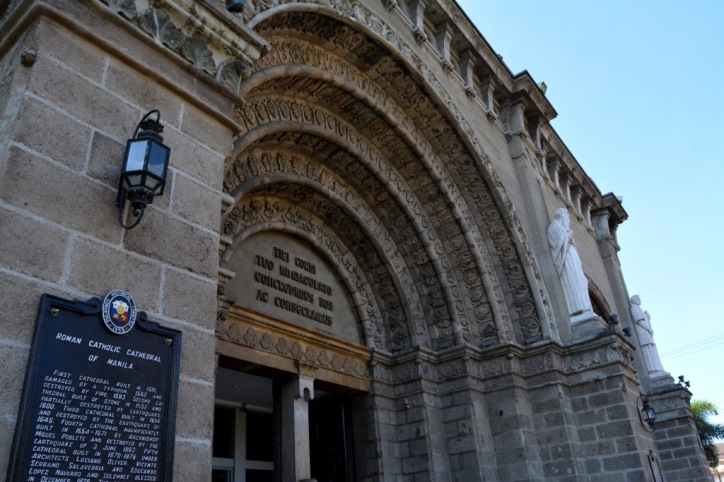
The Manila Cathedral is the seat of the Roman Catholic Archdiocese in Manila and being a country that was ruled for hundreds of years by a Catholic-centric country, it is highly revered in the city. The details were quite simple as compared to many of the cathedrals I’ve seen throughout Europe and even the States but there was elegance in its simplicity. As Ashley and I were standing out front taking pictures of the facade we were approached by a man who offered to give us a guided tour on his Kalesa around Intramuros. With Ashley being the first to admit her knowledge was lacking on the area, we negotiated a rate and climbed aboard his Kalesa. A Kalesa is a horse-drawn covered carriage, or in our case a mule-drawn carriage. Upon climbing aboard we were introduced to our tour guides, one being the more senior and knowledgeable, and the other appearing to be his young apprentice. I can’t for the life of me remember either of their names but they proved to be genuine and engaging guides.

The wall that was first erected around the city center is still largely intact, though very much pockmarked from the shells and bullets from the Battle of Manila. The walled city contained several remnants of the former structures, but more often than not just the memories of the buildings that once were, bombed to oblivion.

Our next stop was at the San Agustin cathedral which is the oldest building in Manila. During the Battle of Manila, they placed a large red cross on the roof, hoping the American troops bombing the city (in an attempt to drive the Japanese from it) would think it was a hospital and not target it. Their gamble paid off. It’s included in the picture above as the lone standing structure after the battle.
Once inside the main nave of the cathedral, looking up at the ceiling you notice this incredible intricate stonework. Only to find out that it is not stonework but rather an outstanding mural meant to replicate an ornate ceiling structure. The mural was painted by a couple of Italian artists and I honestly don’t know what is more impressive, the stonework it provokes or the fact it is so realistically recreated by brushstroke.
Walking through the halls of the cathedral you got a glimpse into what life would have been like for the priests and monks that first inhabited this cathedral in the 17th century.

We made our way through the cathedral, absorbing the oldest remaining structure from a bygone era of Spanish influence, and walked across the street. We stepped into a structure that had been largely restored and once housed four prominent Spanish families. It was evident that the Spanish families wanted to evoke a sense of their native country in the buildings and its European charm shone. Walking into the courtyard which now houses restaurants, a museum, hotel, and shops, truly felt like stepping into the courtyard of an old Spanish villa. This wonderful dichotomy of the Spanish influence and the Asian culture create a very unique and interesting originality to the Philippine experience. Hearing Spanish words mixed into the Filipino dialect is just part of the lasting impression of their Spanish roots.
We got back into the Kalesa and continued our mule-drawn ride around Intramuros, collecting history as we passed the bones of what once was.

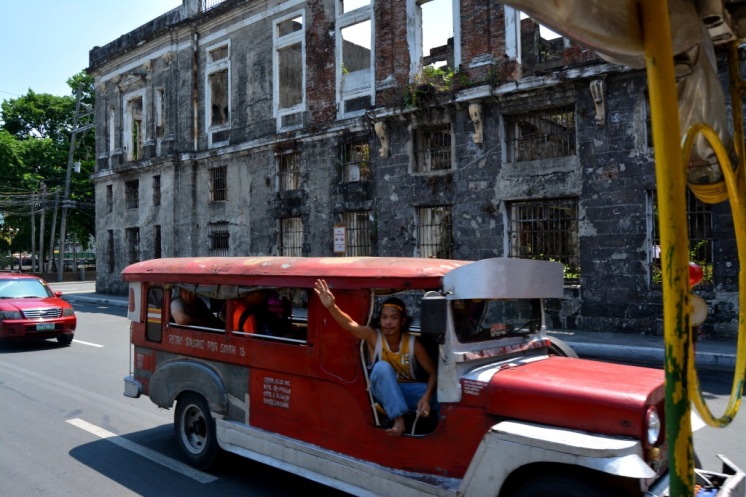
We rode around Intramuros for around an hour and a half and the last stop was Fort Santiago which was the military headquarter for many years and several wars. The entrance to Fort Santiago was captured in a famous World War II image showing a Sherman tank coming through the bombed/bulleted entrance.
Upon entering Fort Santiago you’re met with another significant chapter of Philippine history, that of Jose Rizal. While I confess I was not educated on his historical significance I soon found out about his impact and role in Filipino Independence. Rizol was somewhat of a Renaissance man who lived during the last part of the 19th century. At the time, the Philippines were still under Spanish rule, and Rizal was a voice that came to be the rallying cry for Independence. Professionally he began as a Dentist but worked his way into the hearts of the locals through his writing. Ultimately charged with treason, he was held in a small cell in Fort Santiago before being walked to Luneta (a nearby park) to be executed. His final footsteps are now cast in bronze and set in the street within Fort Santiago. There’s a very nice museum within Fort Santiago devoted to Rizal’s life and death that were worth a stop.

After spending the better part of the morning walking through Fort Santiago we began heading towards a part of Manila that was located on the bay to grab lunch. Ashley was sure not to let a cultural moment pass us by, so we went through Luneta Park to go by the execution site of Rizol and see the tomb/monument to Rizol that is now guarded 24/7 as a sign of respect to one of the great leaders of Filipino Independence.

We soon made our way over to a large aquarium / shopping center close by that contained some good dining options. After asking for suggestions, we made our way to a large restaurant that featured some local Philippine food. I told Ashley that I was keen to try some local food and she was more than willing to oblige. We ordered Adobo (a pork dish slow-cooked in a soy based sauce) and Kare Kare (oxtail in a curry butter sauce with vegetables and assorted other parts of the cow). Along with the meal, I ordered a Philippine original, San Miguel beer which over the trip I became quite fond of. The Adobo was good, as the soy based sauce was balanced with garlic, sugar, and other spices while the meat was very tender. The Kare Kare was an interesting dish. I had never eaten Oxtail before and while it is slow cooked to provide a tender bite, it consists of meat, some sinew, and fat wrapped around the bone from the tail. Additionally, it featured, another part of the cow which was referred to as “towel” and I think was tripe. Having not eaten much of these cuts of meat, it took some getting used to. I’ll confess I was not the biggest fan. However, I realize I’m also a spoiled American and if raised on this, I’m sure would find it quite enjoyable.
Towards the end of the meal, being the generous host she was, Ashley mentioned some other Filipino cuisines she wanted to ensure I tried before leaving. One of the items was Balut. I of course had done some research prior to my visit and had noted the prevalence of this food item in Filipino cuisine and looked into the details. Being fully armed with the information, I quickly told her that while I’m a fairly adventurous eater, I was not willing to take on Balut. For those who want more info on it, click here.
After lunch, our afternoon agenda was less frenzied so Ashley took me to a few of the local shopping establishments. We finished the afternoon by going to Ayala Triangle Park. The fascinating thing about this park is it used to be an airfield just on the outskirts of Manila (though now in the middle of Makati). The three streets around the park which form the triangle were once all runways and only later converted to streets. The old terminal has since been converted to a restaurant but still bears the stamp of its history.

By this time it was getting close to dinner so we headed back to prep for dinner.
My friend Marty and his wife Joce got in that evening and we were all going to meet at a restaurant called 71 Gramercy, which is located on the 71st floor of a residential building in Makati. The views were stunning, the conversation great, and the food satisfying.
We finished off dinner by having drinks on the balconies and then Marty (who previously lived in Manila) gave me a feel for the Manila nightlife.
The next morning we were meeting up to head out on a trip to Corregidor Island, which played a very prominent role in World War II. Early in the morning Ashley swung by my hotel to surprise me with a smorgasbord of Filipino breakfast items.
The textures of all items were so different, but I was truly impressed that everything we ate was from rice. If nothing else, it was truly impressive that so many different foods could be created from the same base product.
After breakfast we met up with Marty and Joce to head down to the docks and catch our ferry to Corregidor. As we’re boarding the ferry boat to this tourist destination I was greeted by a sight that is far too common in the Philippines. I’ll let the picture do the talking.
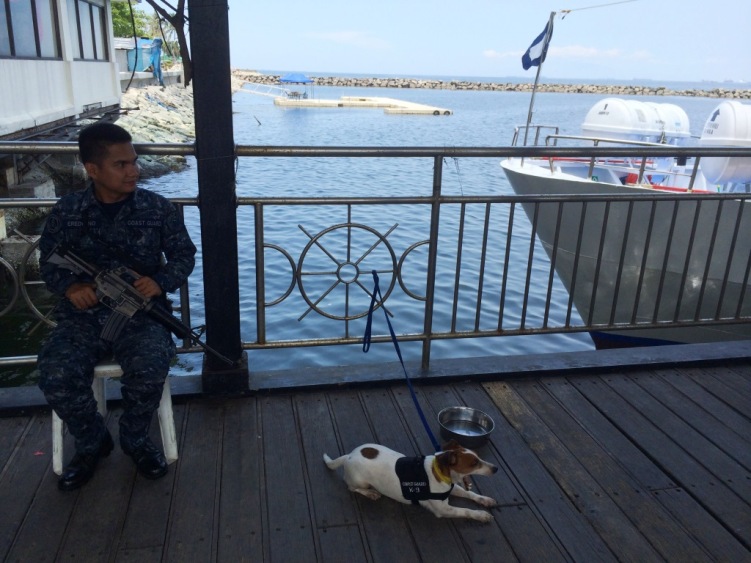
The prevalence of heavily armed guards everywhere becomes just a common sight. You quickly get used to it, but I could not help but think, I wonder what catalysts precipitated nearly every guard at every place of business to be armed with either a sawed of shotgun or an automatic machine gun.
Corregidor Island was established as an American base back in the early 1900’s. Once you step foot on the island and see some of the armaments created out of concrete and steel, from a building standpoint alone it was incredible. They mentioned concrete walls and foundations for cannons that took three years to cure before the guns could be placed! Being a builder, hearing that stuff was incredible.
Our tour boat was running a little late so the first stop we had on the island was at the hotel to grab lunch. The picture below is from the patio where we ate. At certain times I found myself thinking how surreal it must have been during the war to be on this tropical paradise but surrounded by the hell of war.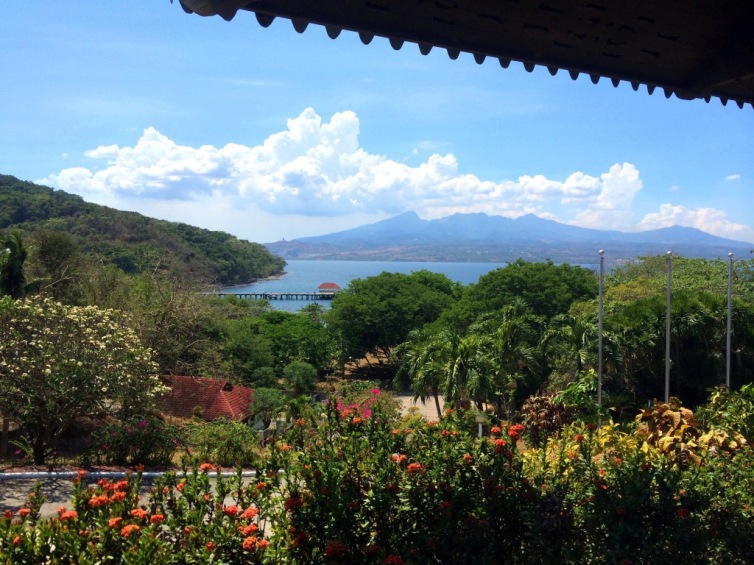
After lunch we began the proper tour and our guide was fantastic. We all hopped into these trolleys that moved you around the island from site to site. Apparently, due to only touring by road we were seeing 10 percent of the old armaments and structures of the base, but even that 10 percent was amazing. We found out that you can spend the night on the island and go on night and day tours that take you off the beaten path to explore all the island has to offer which I’ve since added to my list of things to do. Even so, the tour takes you to many incredible structures that bear evidence of the spectacular battles that raged across the island when occupied by the Americans and then ultimately the Japanese.

As we made our way through a few batteries, we came to the Malinta Tunnel which played a crucial role in the war. Before the island was taken by the Japanese, this would be General MacArthur’s last office in the Philippines prior to being evacuated a couple of months before its fall. Additionally, the President of the Philippines was holed up here when Manila first fell to the Japanese. The engineering of this tunnel system to house troops, storage, offices, and even a hospital was amazing. Ultimately the Japanese occupied the island then the tunnel after taking Manila in 1942. When the Americans ultimately reclaimed Manila and Corregidor, the Malinta tunnel was a final bastion for the Japanese. As the Americans surrounded the island, trapped Japanese soldiers decided they would blow themselves up within the tunnels rather than surrender. What we saw today was largely from restoration undertakings to reclaim the tunnel, but some of the tunnels were still in the same eerie state as when the Japanese detonated it.



Despite the history, I couldn’t help myself when I saw the sign.
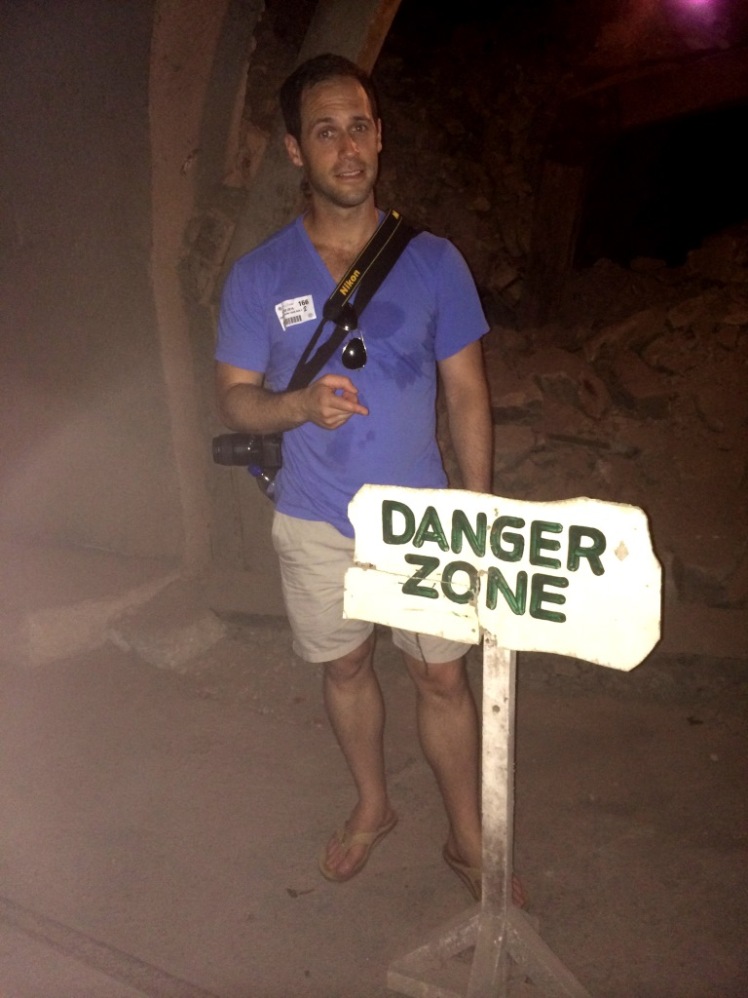
After we made our way through the Malinta tunnel we headed out to see the remnants of the armaments and the barracks. Our tour guide provided very graphic descriptions of the atrocities committed during the war, primarily by the Japanese troops to the Philippine people. This trip served as another reminder of what evils mankind can do to one another. There is far too much to say about each one of the stops we made, so I’ll just attempt to let the pictures tell the story.
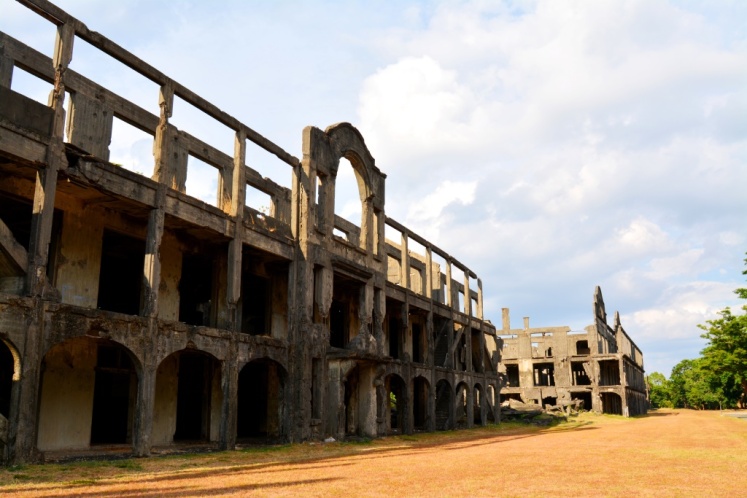

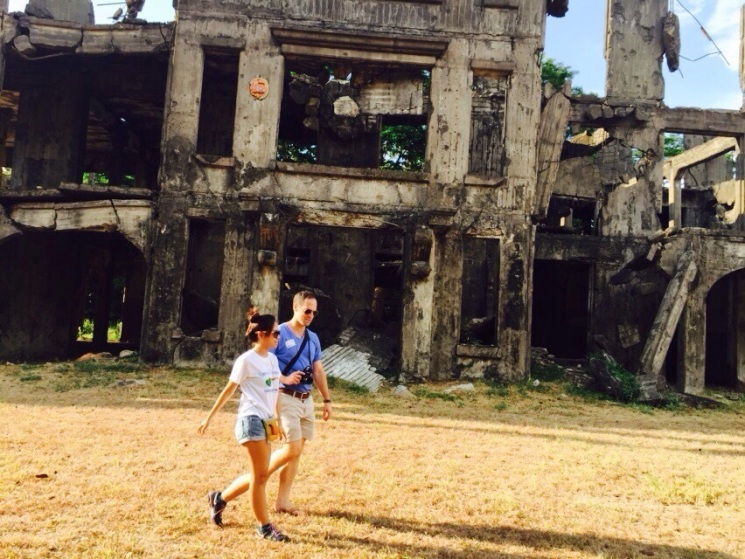





We were soon back on the ferry, making our way for Manila and all thoroughly exhausted from the day. The experience left me that much more keen to soak up the history of the war that wrestled the world from the grips of truly evil men.
When we got back to Manila we grabbed dinner at a cafe that had recently opened up in Makati and had a delicious meal. We were all tired from the day’s long activities and soon called it a night to get ready for the big Pacquia fight!
The fight was set to begin at 8 pm Las Vegas time which would be 11 am Sunday morning Manila time. Marty had gotten us tickets at a local casino that was having a big event for the boxing match. This included hiring a guy that looked. exactly. like. Pacquiao.
I got the feeling this guy did not buy his own drinks at the local bars. The casino had a nice brunch spread and we met up with a couple of friends of Marty’s. Soon enough the fight was about to start so we made our way into the main hall. The place was packed with about 2,000 largely Filipino fans. I too was cheering on Pacquiao as seemed to be the case for most of my fellow Americans from the other side of the world. The place had created a boxing ring in the middle of the hall with four huge monitors above it.
During the broadcast, they showed the singing of the Philippine national anthem and the entire room stood up, hand over heart, with most people singing along. I was moved by the experience and certainly enthralled by a place that was so supportive of their latest national hero, Manny Pacquiao. Then next came the Star Spangled Banner. Being so far away from my native land only made me that much more patriotic so I promptly stood up and put my hand over my heart. I looked around to faintly make out two other people and the far side of the room standing up along with me in the sea of 2,000 seated fans (at least I think they were standing along with me). No one said or threw anything at me, but I could feel the stares. I had to hold back from screaming, ” ‘merica!”
Soon the fight started and the room was fully enraptured with every punch thrown and shimmy made by Pacquaio. However, you could quickly see the fight escaping from Manny’s grips and the outcome seemed inevitable. Much to the chagrin of myself, the room, and the entire country, Manny lost. But ohh how the people supported him. I certainly wished for a different outcome, but would have chosen no other place to see it.
After the fight, we opted for an entirely different side of Filipino culture and made our way to the Ayala Museum.
This well curated museum featured an assortment of historic Filipino artifacts along with a fascinating floor devoted to dioramas telling the history of the Philippines. Getting a sense of perspective for this land allowed me to further enjoy all that it had to offer.
After the museum we grabbed dinner at a Spanish tapas restaurant located in the same complex, called the Greenbelt. This facility is a great example of functional design that incorporates culture, restaurants, shopping, outdoor space, and even a church in a harmonious way.
After dinner we made our way to a rooftop bar to try and capture one of the famed Manila Bay sunsets that I had on my list of things to witness before leaving. The evening sky did not disappoint.
After another long and experience filled day, we called it a night.
The next morning I packed up my things as I would be leaving that afternoon. However Martin, Joce, and Ashley (who had to work but insisted on my experience of something truly Filipino) had a few last stops in mind. First, I was to experience a jeepney. From my initial landing in Manila I was captivated by these colorful and original modes of public transit that blanketed the city streets. They were a very affordable means of transportation (essentially small buses) that locals often rode. The origin of these brightly painted buses begins after the end of World War II. When the American troops withdrew, we left behind a great amount of machinery and equipment, including Jeeps. These military service jeeps would then be sandblasted to expose the underlying metal and then polished and painted into whatever design the Owner wanted. The level of care some of the jeepney Owners devote to their trucks is inspiring. Over the year, the jeeps have been elongated and further decorated to make each jeepney unique. After a few failed attempts, we found our ride.
You definitely have to know where you’re going and where the jeepney’s are stopping but it proved to be a great experience. Unfortunately the jeepneys were not going to our ultimate desired destination, so we cabbed the last bit on our way to the American cemetery. This peaceful and picturesque plot of land was devoted to the thousands of American soldiers that lost their lives during WWII. As you reflect on all the sons and daughters that never came home, the embrace and warmth an American feels from Filipinos reinforces the reason for all these soldiers sacrifices.
As we arrived at the cemetery I was surprised that while being in the middle of such a frenetic city as Manila, the place was so utterly peaceful. We spent the next hour and a half walking through this beautiful and moving memorial to the warriors that sacrificed their lives for the sake of freedom for Americans and the world over.
This last stop was a moving one, and I was so appreciative at Martin’s insistence to showing me it. Taking time out of our busy schedules to pause and reflect on the brave men and women who died for our freedoms is the least we could do. It was a powerful way to leave such a special place.
I was soon headed to the airport, and I can unequivocally say that like MacArthur, I shall return to the Philippines. There are so many other treasures to a country that is home to over 7,000 islands and I look forward to seeing some of them with the warm and friendly Filipinos that call them home. A special thank you to Martin, Ashley, and Joce for making it such a memorable trip for me.

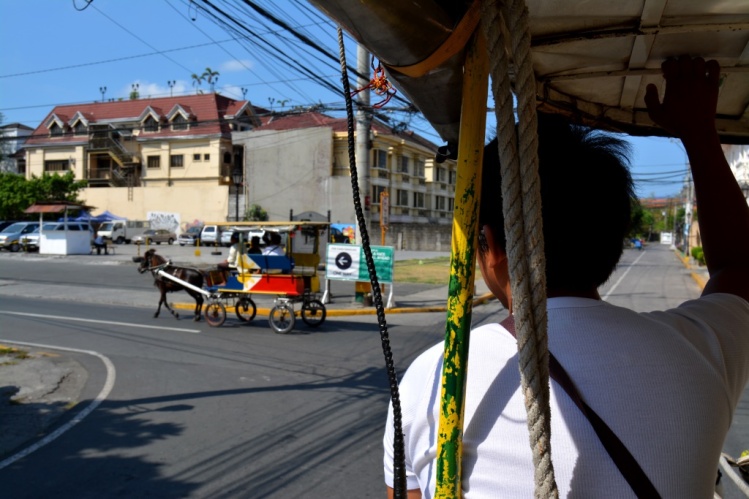
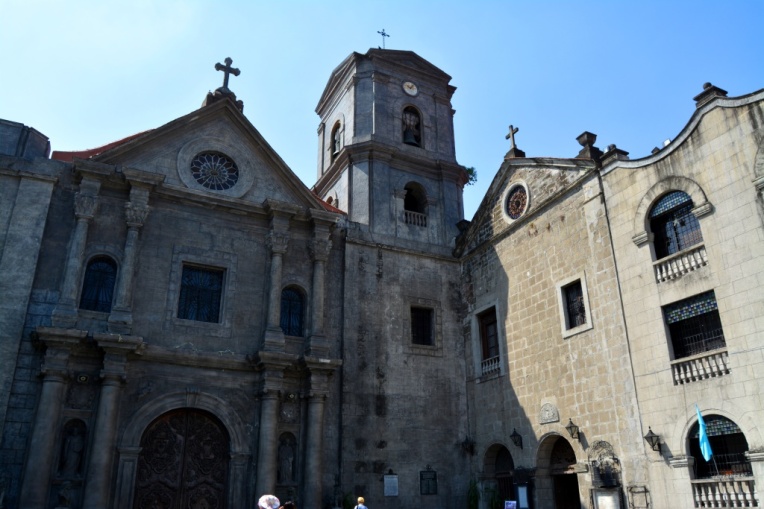
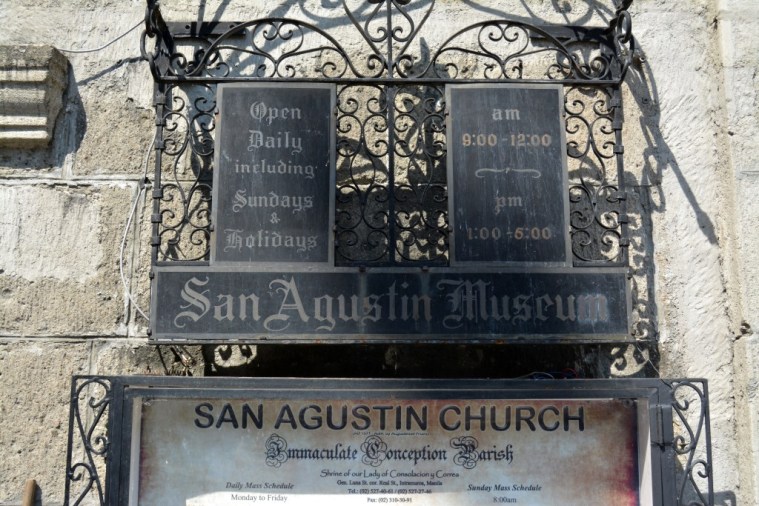




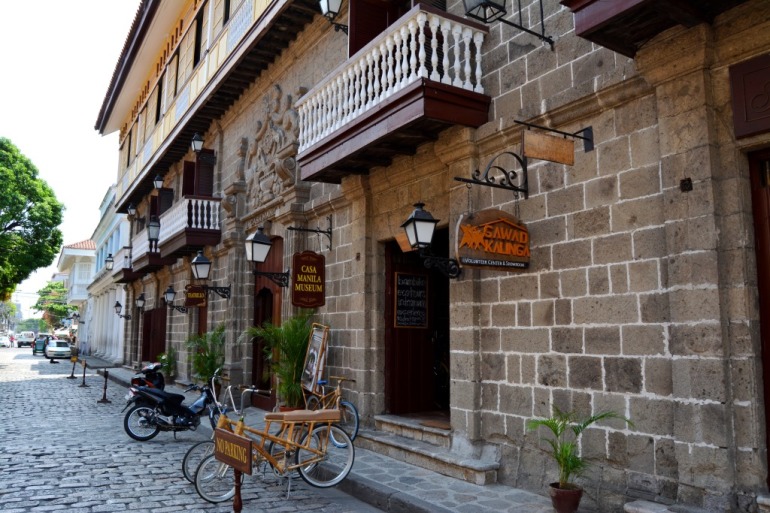






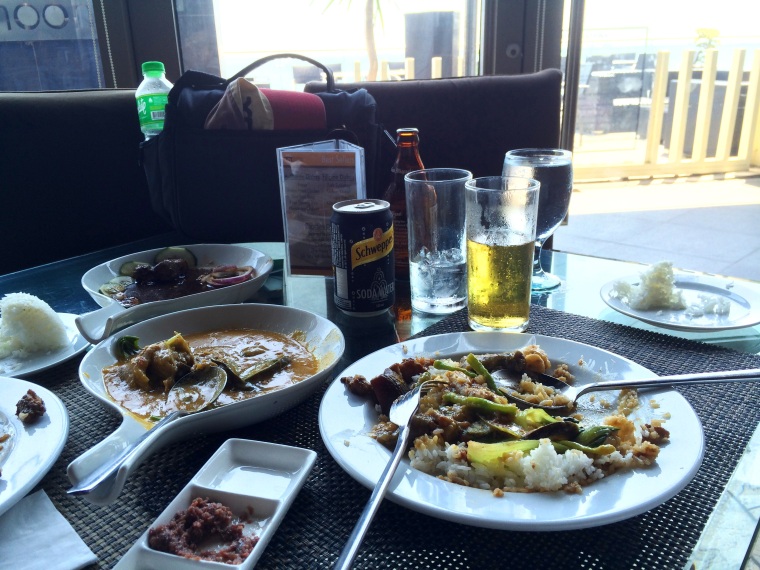

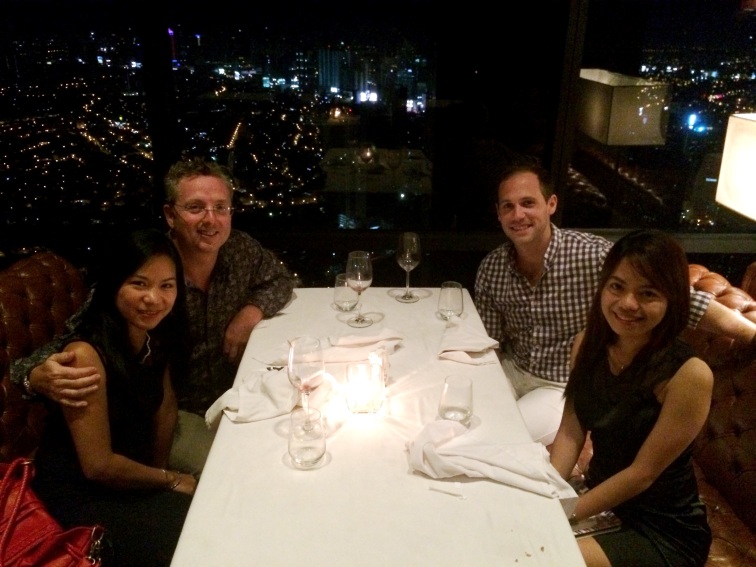
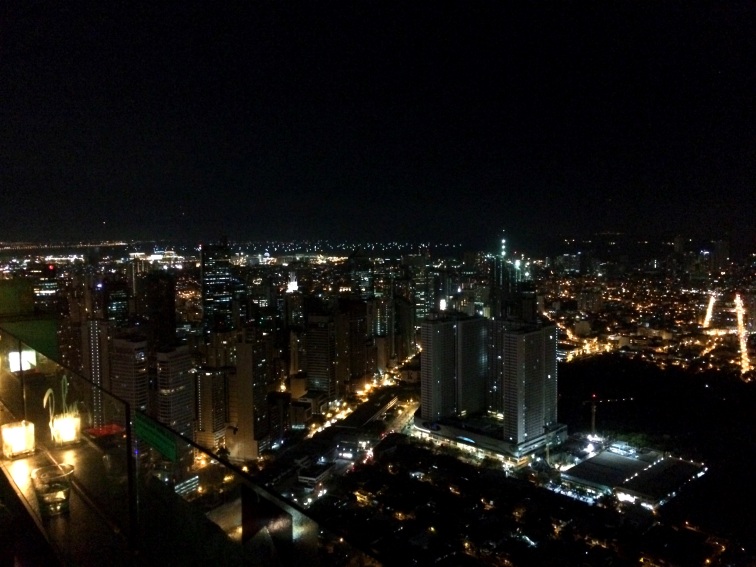





















Hi Evan! I keep on smiling while reading through your blog. I recall every detail you mention because I was there except for the latter part. I’m so glad that you got a chance to ride a jeepney. I saw how interested you are to learn the history of a certain place and I’m quite guilty of not being knowledgeable about it. I was also a tourist. I thought that there is nothing to be proud of my country given the corrupt leaders and dirty government but after our historical tour, I somehow appreciate it. Philippines has wonderful beaches and I recommend you to experience it. Gracias for visiting Manila. I look forward to your next blog.
LikeLike
I really wished you would have tried the balut and then provided a vivid description of what your regurgitation was like…..naw, best that you didn’t. Thanks again for sharing your adventures
LikeLike
Hahaha, a vivid description it would have been! Hope all is well my friend.
LikeLike
I bet you’ve just been itching to use this blog title huh?! How perfect. 🙂 Great post!!
LikeLike
Evan, you are truly welcome my friend it was a pleasure. We look forward to catching up with you this year. 🙂
LikeLike